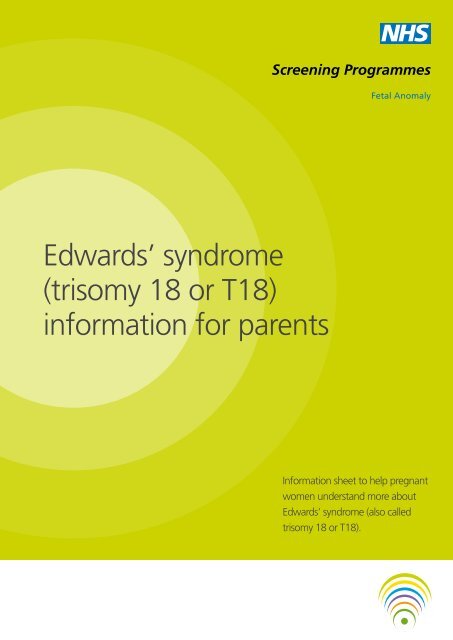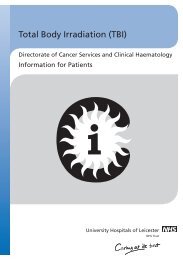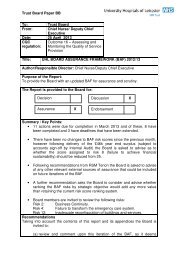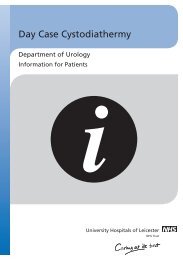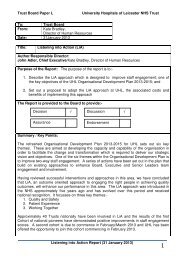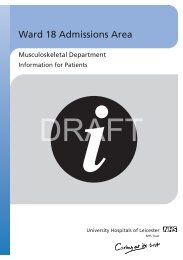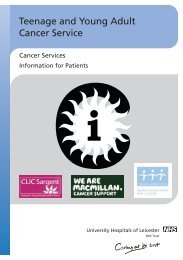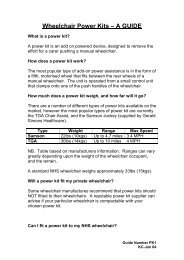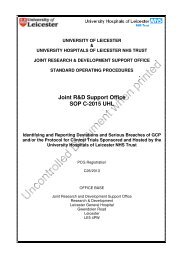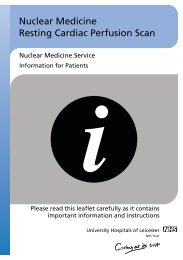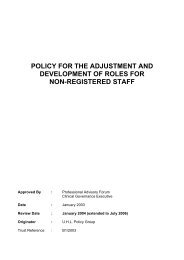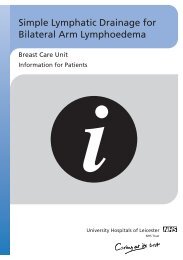Edwards' syndrome (trisomy 18 or T18) information for ... - Library
Edwards' syndrome (trisomy 18 or T18) information for ... - Library
Edwards' syndrome (trisomy 18 or T18) information for ... - Library
You also want an ePaper? Increase the reach of your titles
YUMPU automatically turns print PDFs into web optimized ePapers that Google loves.
Screening ProgrammesFetal AnomalyEdwards’ <strong>syndrome</strong>(<strong>trisomy</strong> <strong>18</strong> <strong>or</strong> T<strong>18</strong>)inf<strong>or</strong>mation f<strong>or</strong> parentsInf<strong>or</strong>mation sheet to help pregnantwomen understand m<strong>or</strong>e aboutEdwards’ <strong>syndrome</strong> (also called<strong>trisomy</strong> <strong>18</strong> <strong>or</strong> T<strong>18</strong>).Edward’s <strong>syndrome</strong> (Trisomy <strong>18</strong> <strong>or</strong> T<strong>18</strong>) inf<strong>or</strong>mation f<strong>or</strong> parents WP_T<strong>18</strong>_V1 June 2009 1
What is T<strong>18</strong>?This rare genetic chromosomal dis<strong>or</strong>der occurs when a baby has three copies of chromosome <strong>18</strong>, rather than theusual two. It is also referred to as <strong>trisomy</strong> <strong>18</strong> <strong>or</strong> Edwards’ <strong>syndrome</strong>.There are three types of the <strong>syndrome</strong>:• Regular (severe) – this is when every cell in the body has three copies of chromosome <strong>18</strong> and accounts f<strong>or</strong>94% of cases.• Mosaic (less severe) – this is when some cells have the usual two copies and some have three copies ofchromosome <strong>18</strong>. The extent and severity of the condition will depend on how many cells have the extracopy of chromosome <strong>18</strong>, but includes learning difficulties.• Partial – this is when there is an extra copy of only a part of chromosome <strong>18</strong>. The effects of this may bemilder but include learning difficulties.An amniocentesis <strong>or</strong> CVS will tell you which type of Edwards’ <strong>syndrome</strong> your baby has.The regular <strong>or</strong> severe f<strong>or</strong>ms of the condition means your baby will have abn<strong>or</strong>malities of the heart, kidneys, brainand bowel. These children will usually also have profound difficulties and require full time care. They are rarelyable to speak, feed themselves, <strong>or</strong> walk. Infants with this condition often have a small head with characteristicfacial features including a small jaw and mouth, upturned nose and low set ears.How is it confirmed?Signs that the baby may have Edwards’ <strong>syndrome</strong> are picked up at the routine <strong>18</strong> +0 − 20 +6 weeks’ fetal anomalyscan. The blood test f<strong>or</strong> Down’s <strong>syndrome</strong> can also suggest the condition is present in approximately 50% ofcases. It can only be confirmed by CVS <strong>or</strong> amniocentesis.What other tests will be offered?You may be offered CVS <strong>or</strong> amniocentesis to confirm the diagnosis and the type of Edwards’ <strong>syndrome</strong>. Once adiagnosis is confirmed you will have the opp<strong>or</strong>tunity to discuss whether you wish to continue with the pregnancy<strong>or</strong> choose to end the pregnancy.Is there any treatment?There’s no cure f<strong>or</strong> Edwards’ <strong>syndrome</strong>, but we can treat some of the symptoms.What is the outlook f<strong>or</strong> the baby?The maj<strong>or</strong>ity of babies with the <strong>syndrome</strong> die bef<strong>or</strong>e birth. After birth, 50% of infants with the full f<strong>or</strong>m die within 1month. Only 10% of babies b<strong>or</strong>n with the condition will survive to one year. Few survive beyond their first year.Those affected by the mosaic and partial f<strong>or</strong>ms may survive to adulthood. Physically, the baby will not developn<strong>or</strong>mally and may have bone abn<strong>or</strong>malities, heart defects and breathing problems. These children will usually alsohave profound learning difficulties and require full time care. They are rarely able to speak, feed themselves, <strong>or</strong> walk.2Edward’s <strong>syndrome</strong> (Trisomy <strong>18</strong> <strong>or</strong> T<strong>18</strong>) inf<strong>or</strong>mation f<strong>or</strong> parents WP_T<strong>18</strong>_V1 June 2009
How common is it?Edwards’ <strong>syndrome</strong> occurs in around 1 in 3000 - 6000 births.How likely is it to happen in a future pregnancy?You are much m<strong>or</strong>e likely to have a n<strong>or</strong>mal, healthy baby in your next pregnancy than to have another babyaffected with Edwards’ <strong>syndrome</strong>. There is no way of preventing Edwards’ <strong>syndrome</strong>. Genetic counselling isgenerally offered to inf<strong>or</strong>m parents of the risk of having another child with the same condition. F<strong>or</strong> regularEdwards’ <strong>syndrome</strong>, the recurrence risk is around 1%.What happens next?You will be given the chance to talk to specialists about what having a baby with this condition might mean toyou and your family. After having time to think about it, some women choose to continue with their pregnancyand do all they can to prepare f<strong>or</strong> having a baby with this condition. Others may choose not to continue with thepregnancy. You will be offered a termination of pregnancy. Whatever you decide, your decision will be respectedand you will be supp<strong>or</strong>ted by your midwife and doct<strong>or</strong>.Where can I get m<strong>or</strong>e inf<strong>or</strong>mation and supp<strong>or</strong>t?You may feel you only want to talk to your partner, family members <strong>or</strong> a particular doct<strong>or</strong> <strong>or</strong> midwife from thehospital. However, there are a lot of other people and <strong>or</strong>ganisations that can provide inf<strong>or</strong>mation, help you makeyour decisions and supp<strong>or</strong>t you in your pregnancy and after it. Some are listed below. You can also talk thingsthrough with the hospital chaplain <strong>or</strong> your own faith leader.Useful websitesAntenatal Results and Choices (ARC)73 Charlotte StreetLondonW1T 4PNTel: 0207 631 0285Email: info@arc-uk.<strong>or</strong>gWebsite: www.arc-uk.<strong>or</strong>gAntenatal Results and Choices (ARC) provides impartial inf<strong>or</strong>mation and individual supp<strong>or</strong>t to parents whetherthey are going through antenatal screening <strong>or</strong> whose unb<strong>or</strong>n baby has been diagnosed with an abn<strong>or</strong>mality.Contact a Family (CAFAMILY)209 to 211 City RoadLondonEC1V 1JNTel: 0808 808 3555Email: info@cafamily.<strong>or</strong>g.ukWebsite: www.cafamily.<strong>or</strong>g.ukContact a Family is a charity which provides supp<strong>or</strong>t, advice and inf<strong>or</strong>mation f<strong>or</strong> families with disabled children,no matter what their condition <strong>or</strong> disability.DIPExPO Box 428WitneyOxonOX28 9EUEmail: info@healthtalkonline.<strong>or</strong>gWebsite: www.healthtalkonline.<strong>or</strong>g &www.youthhealthtalk.<strong>or</strong>gDIPEx has created a unique database of personal and patient experiences through in-depth qualitative researchinto over 40 different illnesses and health conditions. The results of their research are published on two websiteswhich are aimed at patients, their carers, family and friends, doct<strong>or</strong>s, nurses and other health professionals. Theirtarget is to complete at least 100 conditions within the next 5 − 10 years.Edward’s <strong>syndrome</strong> (Trisomy <strong>18</strong> <strong>or</strong> T<strong>18</strong>) inf<strong>or</strong>mation f<strong>or</strong> parents WP_T<strong>18</strong>_V1 June 2009 3


